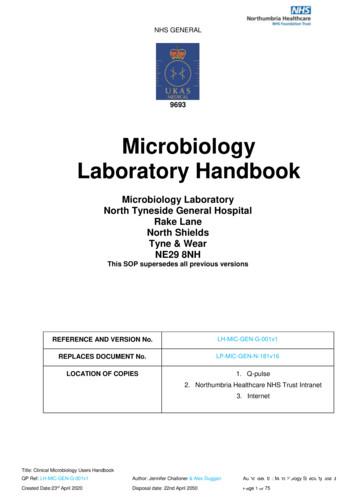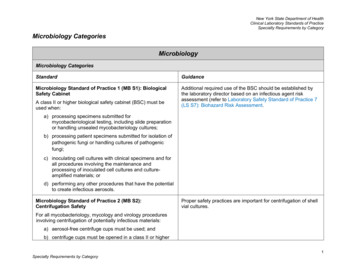MICROBIOLOGY - Dandelon
MICROBIOLOGYCONCEPTS AND APPLICATIONSMichael J. Pelczar, jr.Emeritus Vice President, Graduate Studies and ResearchEmeritus Professor of MicrobiologyUniversity of Maryland*E. C. S. ChanProfessor of Microbiology, Faculty of Medicine, Faculty of DentistryMcGill UniversityNoel R. KriegAlumni Distinguished ProfessorVirginia Polytechnic Institute and State UniversityDiane D, EdwardsScience WriterMema F. PelczarContributorTeehnisohe Hoctechu -DarmstadtFACHBEREICH10 -BI0U)GiE-BlbUothek8chnlttspahnstraB810D - 6 4 2 87 D a r m art&4l1w.4 r.McGRAW-HILL, INC.New York St. Louis San Francisco Auckland Bogota Caracas Lisbon London MadridMexico'Milan Montreal New Delhi Paris San Juan Singapore Sydney Tokyo Toronto
ContentsPreface xxiSupplements Overview xxivPROLOGUE: Discovering the Microbial World 1-jT-—-——? - - y — j AN.OVERVIEWiOR rXMICROBIOLOGY 21 S i /',, , . ,1 Essential Biochemistry for Microbiology 22ij,2 The Scope of Microbiology 563 Characterization of Microorganisms 80 Procaryotic and Eucaryotic Cell Structures 1065PART IINUTRITION AND CULTIVATIONOF MICROORGANISMS 153-PART'ill "* % * IdONTROL F* * - 8 Y ". * -\ MAJOR GROUPS OF \ - MICROORGANISMS* 24rV\/ '""MICROBIAL METABOLISM 303— - — 'VINutritional Requirements and Microbiological Media 1546 Cultivation and Growth of Microorganisms 175 Control of Microorganisms: Principles and Physical Agents 2008 Control of Microorganisms: Chemical Agents 22119 The Major Groups of Procaryotic Microorganisms: Bacteria 242" The Major Groups of Eucaryotic Microorganisms: Fungi, Algae,and Protozoa 271" 1 1 Microbial Metabolism: Energy-Yielding BiochemicalProcesses 30412 Microbial Metabolism: Energy-Requiring BiochemicalProcesses 328
iPART VIJttlCROBIAL GENETICS 34913 Inheritance and Variability 35014-Microbes'and Genetic Engineering 38015 Viruses: Morphology, Classification, Replication 40216 Viruses: Cultivation Methods, Pathogenicity 43617 Normal Flora of the Human Body 454PART VIIIMICROORGANISMS AND-DISEASE: RESISTANCE TO, INFECTION 45318 Host-Parasite Interactions: Nonspecific Host Resistance 47519 The Immune Response: Specific Host Resistance 50020 Practical Aspects of Immunity 52721 Antibiotics and Other Chemotherapeutic Agents 55622 Nosocomial Infections 590PART IXffiCROORGANISMS ANDDISEASE: MICROBIAL589 " 23 Sexually Transmitted Diseases 61424 Airborne Diseases 64625 Foodborne and Waterborne Diseases 68026 Arthropod-Borne Diseases 71527 Wound and Skin Infections Acquired by Direct Contact 74328 Microbiology of the Soil and the Atmosphere 772TVl(*ROBIAL"tCOLOGY77t29 Microbiology of Natural Waters, Drinking Water, andWastewater 80630 Microbiology of Food 84231 Biotechnology: The Industrial Applications of Microbiology 869 APPENDIXESA Answers to the Review Guides A.3B Differentiating Bacterial Species by Biochemical Tests A.7C Use of Exponential Notation and Logarithms in Microbiology A.8D Restriction Endonucleases A.9Further Reading R. 1Credits C.1Glossary G.1IndexesName Index 1.1Organism Index 1.2Subject Index 1.5
'I1ContentiPreface xxiSupplements Overview xxivPROLOGUE: DISCOVERINGTHE MICROBIAL WORLD 1Microbiology, Science, and Society 2Leeuwenhoek and His Microscopes 3Origin of Leeuwenhoek's Animalcules 4Biogenesis versus Abiogenesis 4Disproof of Abiogenesis 5Proof of Biogenesis 5Germ Theory of Fermentation 7Germ Theory of Disease 7Development of Laboratory Techniques to StudyMicroorganisms 8Pure Culture Techniques 8Koch's Postulates 9Developments in Disease Prevention 11 Antisepsis 12 Immunization 12Chemotherapy 14Developments in Nonmedical Microbiology 15Microbiology and Biochemistry 16Microbiology and Genetics (Molecular Biology) 17Solubility of Compounds 28Solubility of lonizable Compounds 28Solubility of Polar Compounds 30Solubility of Nonpolar Compounds 30Amphipathic Compounds 30Concentration of Compounds in Solution 30Acids, Bases, and pH 32Acids 32Bases 32Salts 33Buffers 34Important Biological Compounds 34Carbohydrates 34Lipids 36 Proteins 39Nucleic Acids 42Introduction to Chemical Reactions 46Chemical Reactions 46Enzymes 46 SUMMARY 51KEY TERMS 51REVIEW GUIDE 52REVIEW QUESTIONS 55DISCUSSION QUESTIONS 55DISCOVER!1.1 A Surprising Discovery of Biological 'MirrorImages" 39J ARTJAN OVERVIEW 0 Fd2fjTHE SCOPE OFMICROBIOLOGY1ESSENTIAL BIOCHEMISTRYFOR MICROBIOLOGY 22Atoms and Molecules 23Atoms 23Molecules 24VIII56Cells As the Structural Units of Life 57Classification of Living Organisms 58»s3Classification of Microorganisms 60Kingdom Protista 60Procaryotic and Eucaryotic Microorganisms 60
The Five-Kingdom Concept of Classification 62Archaeobacteria, Eubacteria, and Eucaryotes 63Distinctive Characteristics of the Major Groups ofMicroorganisms 65Protozoa 66Algae 66Fungi 66Bacteria 67Viruses 70Microorganisms and the Environment 71Microbiology As a Science 73Basic Microbiology 73Applied Microbiology 73SUMMARY 75KEY TERMS 75REVIEW GUIDE 76REVIEW QUESTIONS 79DISCUSSION QUESTIONS 79DISCOVER!2.1 Hot Spots (Hydrothermal Vents) on the OceanFloor Provide Home for Microbes 70o CHARACTERIZATION OFMICROORGANISMS 80Pure Culture Techniques 81Isolation and Cultivation of Pure Cultures 81Preservation of Pure Cultures 83Microscopes 84The Light Microscope 85"""The Electron Microscope 87 "Microscopy 88 Bright-Field Microscopy 88Dark-Field Microscopy 88 „Fluorescence Microscopy 89Phase-Contrast Microscopy 90Electron Microscopy 90 Newer Microscopy Techniques andMicroscopes 92.Preparing Microorganisms for Light Microscopy 95Wet-Mount and Hanging-Drop Techniques 95Staining Techniques 95Information Used to Characterize Microorganisms 97Morphological Characteristics 97Nutritional and Cultural Characteristics 97Metabolic Characteristics 97 Antigenic Characteristics 98Pathogenic Characteristics 98Genetic Characteristics 98Automated Technology 99 SUMMARY 101KEY TERMS 101REVIEW GUIDE 102REVIEW QUESTIONS 105DISCUSSION QUESTIONS 105DISCOVER!3.1 Banking Microbes for the Future 84zi PROCARYOTIC ANDEUCARYOTIC CELLSTRUCTURES 106Gross Morphological Characteristics of ProcaryoticMicroorganisms 107Morphology of Bacteria 107Ultrastructure of Procaryotic Microorganisms 112Flagella and Pili 112Glycocalyx 118*Cell Wall 119Cytoplasmic Membrane 124Internal Cell Structures 126Dormant Forms of Procaryotic Microorganisms 128Spores 128Cysts 130Gross Morphological Characteristics of EucaryoticMicroorganisms 130Morphology of Fungi 131Morphology of Algae 133Morphology of Protozoa 134Ultrastructure of Eucaryotic Microorganisms 136Flagella and Cilia 136Cell Wall 138Cytoplasmic Membrane 139Cellular Organelles 139Dormant Forms of Eucaryotic Microorganisms 142Spores 142Cysts 144SUMMARY 147KEY TERMS 147REVIEW GUIDE 148REVIEW QUESTIONS 152DISCUSSION QUESTIONS 152DISCOVER!4.1 How Do You Know Bacterial Flagella Spin IfYou Can't See Them? 115DISCOVER!4.2 The Invasiveness of Spirochetes in Infection 117DISCOVER!4.3 Killer Fungi: Nemesis of Plant Pests 133
SUMMARY 194KEy TERMS 194REVIEW GUIDE 195REVIEW QUESTIONS 198DISCUSSION QUESTIONS 198PART IINUTRITION AND CULTIVATIONOF MICROORGANISMS 153 DISCOVER!6.1 Astounding Extreme Thermophily AmongMicrobes 177NUTRITIONAL REQUIREMENTSAND MICROBIOLOGICALMEDIA 154Chemical Elements As Nutrients 155Carbon 155Nitrogen 155Hydrogen, Oxygen, Sulfur, and Phosphorus 155Other Elements 155Nutritional Classification of Microorganisms 156Media Used for Cultivating Microorganisms 158Media for the Growth of Bacteria 161Media for the Growth of Fungi 162Media for the Growth of Protozoa 163Media for the Growth of Algae 163Special-Purpose Media 163Tissue-Culture Media and Methods 167Animal Cell Cultures 167Plant Cell Cultures 169SUMMARY 170 KEY TERMS 1 70REVIEW GUIDE 171REVIEW QUESTIONS 1 74DISCUSSION QUESTIONS 174-DISCOVER!5.1 One Organism Can Help Another to Grow 157DISCOVER!5.2 Diet, Cancer, and Cell Culture Nutrition!IZ"1 CULTIVATION AND GROWTHj OF MICROORGANISMS 175Physical Conditions for Cultivation ofMicroorganisms 176Temperature 176Gaseous Atmosphere 178pH 181Other Conditions 182Reproduction and Growth of Microorganisms 183Reproduction in Eucaryotic Microorganisms 183Reproduction in ProcaryoticMicroorganisms 187Growth of a Bacterial Culture 188PART IIICONTROL OFMICROORGANISMSFf-f' CONTROL OF! MICROORGANISMS:- J PRINCIPLES AND PHYSICALAGENTS 200Fundamentals of Microbial Control 201Pattern of Death in a Microbial Population 201Conditions That Affect AntimicrobialActivity 202Mechanisms of Microbial Cell Damage 204High Temperatures 204Moist Heat 204Dry Heat 207Incineration 208Low Temperatures 209Radiation 210Ionizing Radiation 210Nonionizing Radiation 211vFiltration 212Membrane Filters 213High-Efficiency Particulate Air (HEPA) Filters 213Desiccation 215SUMMARY 216KEY TERMS 216REVIEW GUIDE 217REVIEW QUESTIONS 220DISCUSSION QUESTIONS 220DISCOVER!7.1 When Is a Microbe Really Dead? 203DISCOVER!7.2 Depuration of Shellfish to ControlMicroorganisms 213
CONTROL OFi j i MICROORGANISMS: CHEMICALAGENTS 221Terminology of Chemical Antimicrobial Agents 222Characteristics of an Ideal Chemical Agent 222Major Groups of Disinfectants and Antiseptics 223Phenol and Related Compounds 223Alcohols 225Halogens 226Heavy Metals and Their Compounds 228Detergents 228Evaluation of Antimicrobial Potency of Disinfectantsand Antiseptics 231Tube-Dilution Technique 231Agar-Plate Technique 231Phenol-Coefficient Technique 231Chemical Sterilants 233,Ethylene Oxide 233/3-Propiolactone 234Glutaraldehyde 234Formaldehyde 234SUMMARY 236KEY TERMS 236REVIEW GUIDE 237REVIEW QUESTIONS 240DISCUSSION QUESTIONS 240DISCOVER!8.1 Bacteriostatic or Bactericidal? 223PART IVrMAJOR GROUPS OF MICROORGANISMS 241Q THE MAJOR GROUPS OFPROCARYOTICMICROORGANISMS:BACTERIA 242Bergey's Manual of Systematic Bacteriology 243Eubacteria and Archaeobacteria 243 The Eubacteria 244Gram-Negative Eubacteria 244Gram-Positive Eubacteria 258Mycoplas'mas 261The Archaeobacteria 263Methanogens 263Red Extreme Halophiles 264Sulfur-Dependent Archaeobacteria 264Thermoplasmas 264SUMMARY 265KEY TERMS 265REVIEW GUIDE 266REVIEW QUESTIONS 270DISCUSSION QUESTIONS 270DISCOVER!9.1 Magnetic Bacteria 247DISCOVER!9.2 Endospore Formers That Kill Insect Pests 261-I A1UTHE MAJOR GROUPS OFEUCARYOTICMICROORGANISMS: FUNGI,ALGAE, AND PROTOZOA 271Classification of the Fungi 272The Slime Molds 272The Flagellated Lower Fungi 273The Terrestrial Fungi 279Classification of the Algae 286The Green Algae 287The Diatoms and Golden-Brown Algae 289The Dinoflagellates 292 ' The Euglenoids 294Classification of the Protozoa 294The Flagellates 295The Amoebas 296The Sporozoa 297The Ciliates 298SUMMARY 299KEY TERMS 299REVIEW GUIDE 300REVIEW QUESTIONS 302DISCUSSION QUESTIONS 302DISCOVER!10.1 The Beautiful Diatoms and Their ManyUses 291DISCOVER!10.2 Some Photosynthetic Algae Also EatBacteria! 293
PART VMICROBIAL METABOLISM 30311MICROBIAL METABOLISM:ENERGY-YIELDINGBIOCHEMICAL PROCESSES 304Energy Requirements of Microbial Cells 305Major Energy-Yielding Sources forMicroorganisms 306Chemical Energy and Energy Transfer 306Energy Transfer Between Exergonic andEndergonic Chemical Reactions 306Generation of ATP by Microorganisms 308Substrate-Level Phosphorylation 308Oxidative Phosphorylation 308Photophosphorylation 311Pathways for Dissimilation of Nutrients 315Dissimilation of Complex Nutrients 315Glycolysis 316Regeneration of NAD 318Fermentation and Respiration As Related toHabitat 321SUMMARY 323KEY TERMS 323REVIEW GUIDE 324REVIEW QUESTIONS 327DISCUSSION QUESTIONS 327 DISCOVER!11.1 Uncoupling Agents: A Group of Unusual CellPoisons 31312"MICROBIAL METABOLISM:ENERGY-REQUIRINGBIOCHEMICAL PROCESSES 328Energy Utilization for Biosynthetic Processes 329 lBiosynthesis of Nitrogenous Compounds 330Biosynthesis of Amino Acids and Proteins 330Biosynthesis of Nucleotides and NucleicAcids 332 Biosynthesis of Carbohydrates 335Energization of Monosaccharides 336Biosynthesis of Cell-Wall Peptidoglycan 336Biosynthesis of Lipids 340Biosynthesis of Long-Chain Fatty Acids 340Biosynthesis of Phospholipids 340Energy Utilization for Processes Other ThanBiosynthesis 342Transport of Nutrients into Cells 342Motility 343SUMMARY 345KEY TERMS 345REVIEW GUIDE 346REVIEW QUESTIONS 348DISCUSSION QUESTIONS 348DISCOVER!12.1 193,000,000 Tons! 331PART VIMICROBIAL GENETICS 34913INHERITANCE ANDVARIABILITY 350Chromosomes of Procaryotic and EucaryoticCells 351Replication of DNA 351Transcription and Translation of GeneticInformation 355Transcription 355Translation 359Variability in Microorganisms 361Phenotypic Changes 361Genotypic Changes 361Plasmids 370Regulation of Gene Expression 371Enzyme Induction 372End-Product Repression 372SUMMARY 375KEY TERMS 375REVIEW GUIDE 376REVIEW QUESTIONS 379DISCUSSION QUESTIONS 379DISCOVER!13.1 PCR—The Marvelous Tool 357DISCOVER!13.2 Oil-Eating Bacteria Await Call to Duty 371
14MICROBES AND GENETICENGINEERING 380Introduction to Genetic Engineering 381Why Microorganisms Are Useful in GeneticEngineering 381From the Laboratory to IndustrialApplication 381Producing a Genetically Engineered Bacterium 3827Isolating Plasmid DNA 382Restriction Endonucleases and Sticky-EndedDNA 384Constructing Recombinant Plasmids 385Placing Recombinant Plasmids into RecipientBacteria 387Propagating Recombinant Plasmids 389Problems Involved in Gene Cloning 390Benefits and Potential Hazards of GeneticEngineering 392Benefits of Genetic Engineering 392Potential Hazards of Genetic Engineering 395Regulation of Genetic Engineering 395SUMMARY 396KEY TERMS 396REVIEW GUIDE 397REVIEW QUESTIONS 400DISCUSSION QUESTIONS 400DISCOVER!14.1 Engineering a Vaccine Against HepatitisType B 393Morphology and Chemical Composition ofBacteriophages 409Classification and Nomenclature ofBacteriophages 411System of Classification Based on Differences inTranscriptional Processes 411 Bacteriophages of Escherichia coli 414Bacteriophage Life Cycles 415The Lytic Life Cycle—Virulent Phages 415The Lysogenic Life Cycle—TemperatePhages 418Nonintegrative Lysogeny 419Morphology and Chemical Composition of Animaland Plant Viruses 421Morphology 422Chemical Composition 422Classification and Nomenclature of Animal and PlantViruses 423System of Classification Based on Physical,Chemical, and Biological Characteristics 423Replication of Animal and Plant Viruses 424Attachment (Adsorption) 424Penetration 425Biosynthesis of Virus Components 427Maturation and Assembly 427Release 429 ?SUMMARY 430KEY TERMS 430REVIEW GUIDE 431REVIEW QUESTIONS 435DISCUSSION QUESTIONS 435DISCOVER!15.1 Bacteriophages As Therapeutic Agents 409fART.MII'IRUSES.401IC1JVIRUSES: MORPHOLOGY,CLASSIFICATION,REPLICATION 402General Characteristics of Viruses 403Basic Morphology of Viruses 403Nucleic Acids 404Other Chemical Components 407Replication 408The Discovery of Bacteriophages 40816VIRUSES: CULTIVATIONMETHODS,PATHOGENICITY 436Cultivation of Bacteriophages 437The One-Step Growth Curve 438Cultivation of Animal Viruses 439Living Animals 439Embryonated Chicken Eggs 439Tissue Cultures 439Cultivation of Plant Viruses 442"Viruslike" Infectious Agents 444Viroids 444Prions 444Viruses and Cancer 444Oncogenic DNA Viruses 446Oncogenic RNA Viruses 447
—SUMMARY 449KEY TERMS 449REVIEW GUIDE 450REVIEW QUESTIONS 452DISCUSSION QUESTIONS 452DISCOVER!?16.1 Oncogenes and Cancer 445DISCOVER!16.2 The AIDS Virus Has RNA As Its HereditaryMaterial 447DISCOVER!16.3 What? The Wart Virus Is Deadly? 448PART VI11MICROORGANISMS ANDDISEASE: RESISTANCE TOINFECTION 45317NORMAL FLORA OF THEHUMAN BODY 454Normal Flora of the Healthy Human Host 455Origin of the Normal Flqra 456Effect of the Normal Flora on the Human Host 456Germfree Life 456 Effect of Antimicrobial Agents on the NormalFlora 458Characteristics of Normal Flora Organisms 459Distribution and Occurrence of the Normal Flora 460Blood, Body Fluids, and Tissues 460Skin 460Eye 465Respiratory Tract 465Mouth 466Gastrointestinal Tract 468Genitourinary Tract 470SUMMARY 471KEY TERMS 471REVIEW GUIDE 472REVIEW QUESTIONS 474DISCUSSION QUESTIONS 474DISCOVER!17.1 Antibiotic-Associated Colitis 459DISCOVER!17.2 Candida albicans, A Treacherous Guest! 469-t18HOST-PARASITEINTERACTIONS: NONSPECIFICHOST RESISTANCE 475The Microorganism As a Pathogen 476Microbial Virulence Factors 476Predisposing Factors of Host Resistance 479Environmental Resistance Factors 480Species, Racial, and Individual Resistance 480External Defense Mechanisms 481Skin and Mucous Membranes 481Chemical Secretions 481Naturally Occurring Microbial Flora 483Internal Defense Mechanisms 483Inflammation 484Fever 485Natural Killer Cells 485Phagocytic Cells 487Soluble Mediators: Complement, Lymphokines,, Interferon 491SUMMARY 496KEY TERMS 496REVIEW GUIDE 497REVIEW QUESTIONS 499DISCUSSION QUESTIONS 499DISCOVER!18.1 Why Not Immunization of Green Plants? 48319THE IMMUNE RESPONSE:SPECIFIC HOSTRESISTANCE 500Specific Immunity.and the Immune Response 501The Dual Nature of Specific Immunity 501Characteristics of the Specific ImmuneResponse 501The Lymphocytes 501The Immune System 502Humoral Immunity 503The Antibody Response 503Mediators of Humoral Immunity 505The Basic Structure of an Antibody 506Antibody Classes and Functions 506Maturation of the Immune Response 509Immunologic Memory 509Antigens 510Specificity and Immunogenicity 510Natural versus Artificial Antigens 511Soluble versus Cellular Antigens 511Thymus-Dependent and Thymus-lndependentAntigens 512Adjuvants 513
Hypersensitivity 513Immediate-Type, or Anaphylactic,Hypersensitivity (Type I) 513Complement-Mediated, or Cytolytic,Hypersensitivity (Type II) 514Immune-Complex, or Arthus, Hypersensitivity(Type III) 514Delayed, or Cell-Mediated, Hypersensitivity (Type IV) 515Cellular Immunity 515Transplantation Immunity 515Cellular Immunity to Viruses 516Implications of the T-Cell Response 517Acquisition of Specific Immunity 518Natural versus Passive Acquisition ofvImmunity 518Antibody Therapy and Immunotherapy 518Infection, Immunity, and Immunodeficiency 518Immune Defects of T, B, or NK Cells or ofMacrophages 519Effects of Immunodeficiency on AntibacterialDefenses 519Effects of Immunodeficiency on AntiviralDefenses 520Effects of Immunodeficiency on AnticancerDefenses 520SUMMARY 522KEY TERMS 522REVIEW GUIDE 523REVIEW QUESTIONS 526DISCUSSION QUESTIONS 526DISCOVER! 19.1 1987 Nobel Prize in Physiology or MedicineGoes to an Immunologist 51120PRACTICAL ASPECTS OFIMMUNITY 527Measurements of Humoral Immunity (Antibodies) 528Precipitation Tests 528Agglutination Tests 534Complement-Fixation Tests 540Radioimmunoassays 540Enzyme-Linked Immunosorbent Assays(ELISAs) 542Immunofluorescence 543Production of Monoclonal Antibodies 546Measurements of Cell-Mediated Immunity 548Intradermal Tests for Cell-Mediated Immunity inHumans 548Test for Migration Inhibitory Factor (MIF) 548Mixed Lymphocyte Reaction (MLR) 550Cell-Mediated Cytotoxicity (CMC) 550SUMMARY 552KEY TERMS 552REVIEW GUIDE 553REVIEW QUESTIONS 555DISCUSSION QUESTIONS 555DISCOVER!20.1 Immunologic Techniques Provide New Weaponsin War Against1 Cancer 54921ANTIBIOTICS AND OTHERCHEMOTHERAPEUTICAGENTS 556The Dawn of Chemotherapy 557Ehrlich and the Discovery of Salvarsan 557Domagk, Trefouel, and the Discovery ofSulfonamides 557'' Fleming and the Discovery of the AntibioticPenicillin 558Ideal Qualities of a Chemotherapeutic Agent 560Isolation of Antibiotic-Producing Microorganisms fromNature 560Kinds of Antibiotics Based upon Their ChemicalStructure 562The /3-Lactam Antibiotics 564The Macrolides 566The Aminoglycosides 566The Tetracyclines 566The Polypeptide Antibiotics 567The Polyenes 567Other Antibiotics 568Mode of Action of Antibiotics 568Inhibitors of Cell-Wall Synthesis 568Antibiotics That Damage the CytoplasmicMembrane 570,Antibiotics That Inhibit Nucleic Acid and ProteinSynthesis 570Development of Antibiotic-Resistant Bacteria 571Transmission of Antibiotic Resistance 572Synthetic Chemotherapeutic Agents 572Synthetic Antibacterial Agents 573Synthetic Antiviral Agents 576Synthetic Antiprotozoan Agents 577Assay of Antibiotics 577Chemical Assay 577Biological Assay 577Microbial Susceptibility to ChemotherapeuticAgents 578Tube-Dilution Techniq
DISEASE: MICROBIAL 589 " 22 Nosocomial Infections 590 23 Sexually Transmitted Diseases 614 24 Airborne Diseases 646 25 Foodborne and Waterborne Diseases 680 26 Arthropod-Borne Diseases 715 27 Wound and Skin Infections Acquired by Direct Contact 743 TV l(*ROBIAL"tCOLOGY 77t 28
An Introduction to Clinical Microbiology Susan M. Poutanen, MD, MPH, FRCPC . Objectives 1. To provide an introduction to a typical microbiology laboratory 2. To address specific microbiology laboratory test issues as they apply to public health. Department of Microbiology Who we are Shared microbiology service between TML (UHN & MDS) and MSH
Industrial microbiology Medical and pharmaceutical microbiology Rumen microbiology Space microbiology 1.2 Definitions Milk and milk products occupy a more significant role in the human food profiles. The study of microorganisms that are associated with milk and milk products in all aspects is defined as "Dairy Microbiology". 1.2 .
General Microbiology Manual _ Abdelraouf A. Elmanama Ph. D Microbiology 7 Introduction Welcome to the microbiology laboratory. The goal of the laboratory is to expose students to the wide variety of lives in the microbial world. Although the study of microbiology includes
Title: Clinical Microbiology Users Handbook QP Ref: LH-MIC-GEN-G-001v1 Author: Jennifer Challoner & Alex Duggan Authorised by: Microbiology Specialty board Created Date:23rd April 2020 Disposal date: 22nd April 2050 Page 1 of 75 9693 Microbiology Laboratory Handbook Microbiology Laboratory North Tyneside General Hospital Rake Lane North Shields Tyne & Wear NE29 8NH This SOP supersedes all .
Microbiology H Core 4 3 30 70 100 4 MBH- 204 Food Microbiology H Core 4 3 30 70 100 4 MBS- 205 Bioinformatics S Core 2 2 15 35 50 2 Practical MBP- 206 Microbial Genetics, Molecular Biology Pract 4 4 30 70 100 4 MBP- 207 Environmental Microbiology and Food Microbiology Pract 4 4 30 70 100 4
Microbiology Categories. Microbiology . Microbiology Categories Standard . Guidance; Microbiology Standard of Practice 1 (MB S1): Biological . Additional required use of the BSC should be established by the laboratory director
GENERAL MICROBIOLOGY Requirements in this section apply to ALL of the subsections in the microbiology laboratory (bacteriology, mycobacter iology , mycology , par asitology , molecular microbiology , and virology). When the microbiology depar tment is inspected by a team, each member of the t
53 Patricia m Tille Bailey and Scotts Diagnostic Microbiology 1 54 Connie R Mahon Textbook of Diagnostic Microbiology 1. . 57 Arti Kapil Ananthanarayan Textbook of Microbiology 5 58 J Joseph marr Molecular Medical Parasitology 1 59 David Greenwod Medical Microbiology 2 60 Subhash C . Parija Textbook of practical microbiology 11























